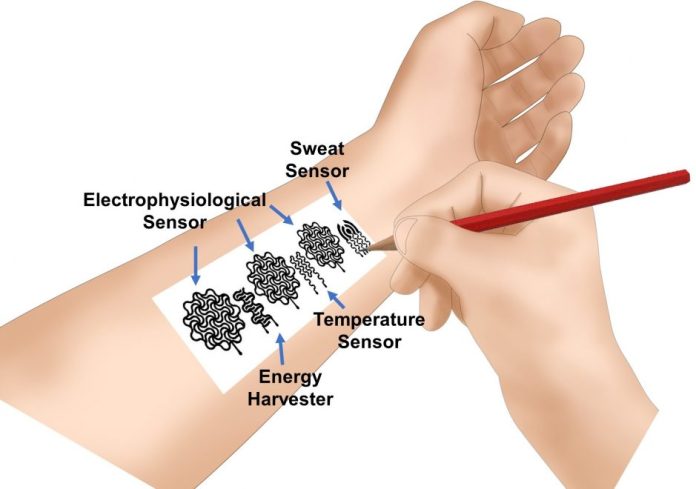By Gina Roos, editor-in-chief
Engineers at the University of Missouri reported that it is possible to monitor your personal health by using pencils and paper to draw a bioelectronic device on your skin. The study shows that engineers took a low-cost approach to developing on-skin biomedical electronic devices.
Instead of developing on-skin electronics that are typically made by patterning conventional inorganic materials, novel organic materials, or nanomaterials on flexible polymer substrates, which can be costly and complex, the study describes the use of everyday pencils and paper as tools to create cost-effective and disposable on-skin electronic devices, which range from biophysical sensors and sweat biochemical sensors to thermal stimulators, humidity energy harvesters, and transdermal drug-delivery systems.
The researchers also demonstrated pencil-paper−based antennas, 2D and 3D circuits, and reconfigurable structures.
“Many existing commercial on-skin biomedical devices often contain two major components — a biomedical tracking component and a surrounding flexible material, such as plastic — to provide a supportive structure for the component to maintain an on-skin connection with a person’s body,” said Zheng Yan , an assistant professor in the College of Engineering , in a statement.
“The conventional approach for developing an on-skin biomedical electronic device is usually complex and often expensive to produce,” he added. “In contrast, our approach is low-cost and very simple. We can make a similar device using widely available pencils and paper.”
The study indicated that pencil-drawn graphite patterns were used as conductive traces and sensing electrodes, while office copy papers were used as the substrate. The researchers found that pencils containing more than 90% graphite were able to conduct a high amount of energy.
With 93% graphite pencils, they were able to create a variety of on-skin bioelectronic devices drawn on commercial office copy paper. The study found that the devices could perform real-time, continuous, and high-fidelity monitoring for a range of vital biophysical and biochemical signals, including skin temperatures; electrocardiograms; electromyograms; alpha, beta, and theta rhythms; instantaneous heart rates; respiratory rates; and sweat pH, uric acid, and glucose, as well as deliver programmed thermal stimulations. The researchers also discovered that the recorded signals were comparable to those measured with conventional methods.
Researchers believe that a biocompatible spray-on adhesive could be used on the paper to help it stick better to skin. The next step is to further develop and test the use of the biomedical components, including electrophysiological, temperature, and biochemical sensors.
The researchers see broad applications across home-based, personalized health care, education, and remote scientific research, such as during the Covid-19 pandemic. These applications range from drawing a biomedical device to monitoring a person’s sleep levels to conducting research at home.
The study, “Pencil-paper on-skin electronics ,” was published in Proceedings of the National Academy of Sciences. Research funding was provided by a University of Missouri startup fund and grants from the National Science Foundation, the Air Force Office of Scientific Research, and the National Institutes of Health.
Advertisement
Learn more about Electronic Products Magazine







